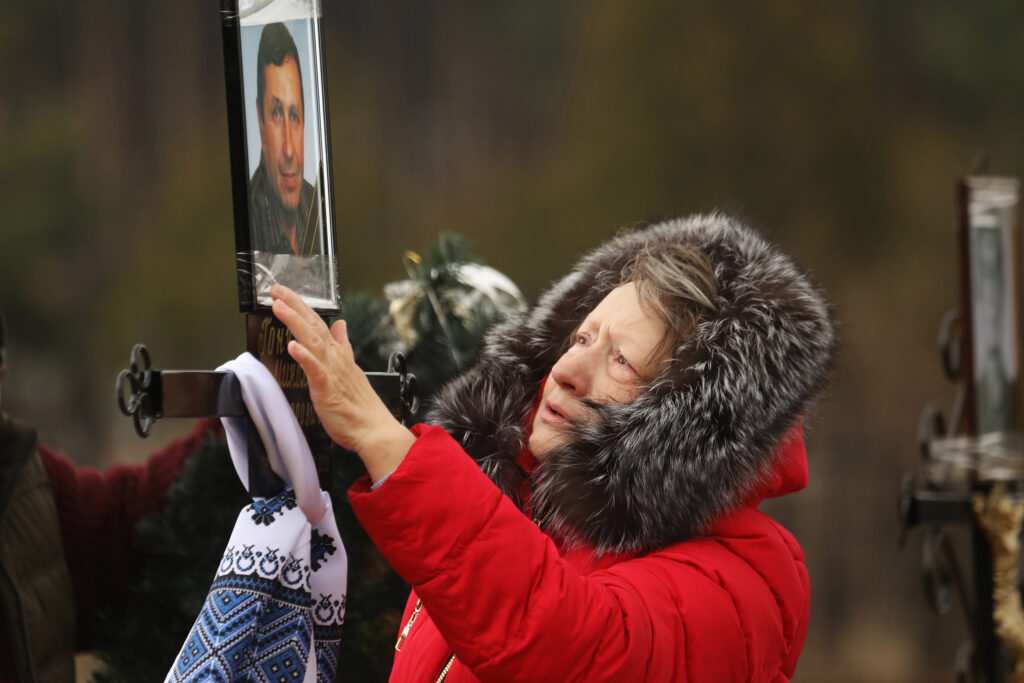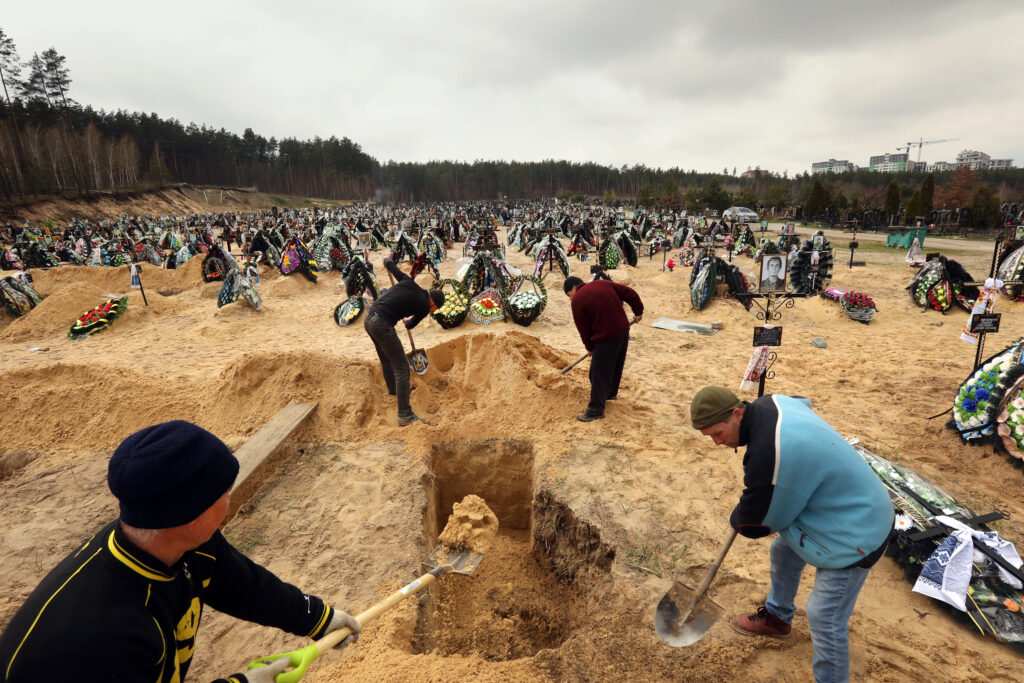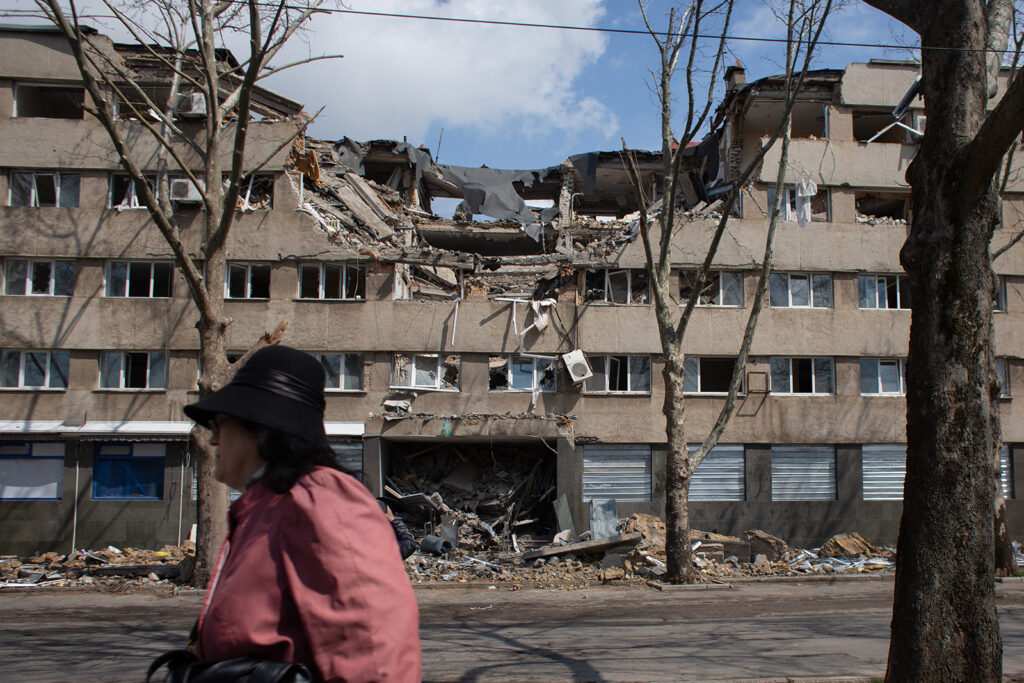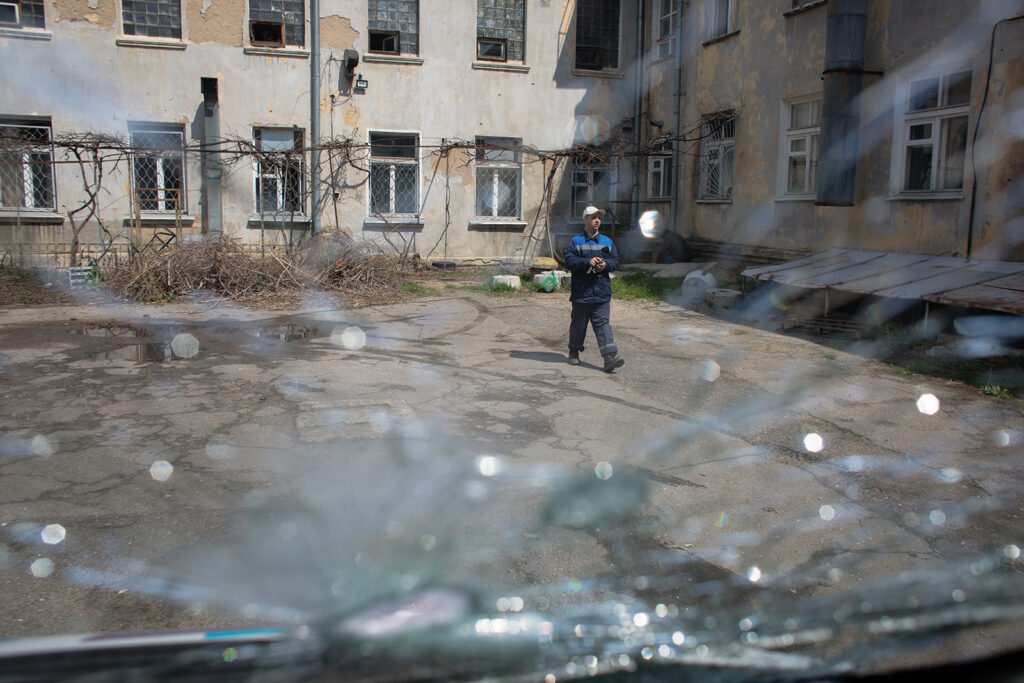Russian President Vladimir Putin claimed victory in the battle for the southern Ukrainian port of Mariupol on Thursday as newly released satellite images from just outside the city revealed an apparent burial site where a local official said Russian troops were depositing dead civilians.
Ukrainian leaders refused to surrender the battered city, a key target in Russia’s war strategy. But the end appeared imminent, with the city’s last holdouts sheltering in a sprawling steel mill.
Putin announced in a televised meeting with his defense minister that he had ordered his forces not to attack the Azovstal steel plant but to blockade the compound so tightly that “not even a fly comes through.”

Those trapped include soldiers, children and the elderly, Ukrainian President Volodymyr Zelenskyy told a French television station Thursday.
“It is not more like a war, but a terrorist operation by Russia against Mariupol and the people of this city,” he said.
After weeks of fighting, the once-thriving city of nearly 500,000 people is now a sea of rubble, three-fourths of its population displaced or dead.
The satellite images from Maxar Technologies, a U.S. space technology company, showed rows of graves stretching from an existing cemetery in the town of Manhush, 12 miles west of Mariupol.

“We finally found where the occupiers hide the bodies of dead Mariupol citizens,” Petro Andriushchenko, an adviser to the mayor of Mariupol, wrote on Facebook.
He said that the graves were 30 meters long — nearly 100 feet — and that the bodies were wrapped in plastic and dropped off by trucks, asserting: “This is a direct proof of military crimes and an attempt to hide them.”
The allegations could not be independently verified, but they are consistent with evidence of other mass civilian killings by Russian troops in Bucha, a suburb of Kyiv, the Ukrainian capital.
Control of Mariupol, on the Sea of Azov, would allow Russia to create a land corridor connecting Russian-controlled parts of eastern Ukraine to Crimea, the peninsula it illegally seized in 2014.

Russian Defense Minister Sergei Shoigu said Thursday that Mariupol had been “liberated,” a term his government has used to portray its invasion as a humanitarian mission to save Ukraine from “neo-Nazis” — even as international powers rally in support of the democratic country and its Jewish president.
In Washington on Thursday, President Joe Biden announced an additional $800 million in defense aid to Ukraine.
The 8-week-old war has left thousands of civilians dead and created more than 5 million refugees. Those figures are certain to grow as Russia presses on with a massive offensive in the east.

Biden said “there is no evidence yet that Mariupol has completely fallen” and predicted that the Russian offensive in eastern Ukraine was “going to be limited in terms of geography but not limited in terms of brutality.”
Ukrainian officials said Thursday that there would be additional attempts to evacuate civilians from the region. They also said they wanted to negotiate the status of Mariupol.
“We demand from the Russians an urgent humanitarian corridor from the Mariupol plant Azovstal,” Deputy Prime Minister Iryna Vereshchuk said on the messaging app Telegram. “There are now about 1,000 civilians and 500 wounded soldiers. They all need to be removed from Azovstal today.”
Separately, presidential adviser Mykhailo Podolyak said he was prepared to travel to Mariupol for new negotiations “without any conditions” after several previous rounds of talks failed to produce a cease-fire.
“We’re ready to hold a ‘special round of negotiations’ right in Mariupol,” he said on Twitter. “One on one. Two on two. To save our guys, Azov, military, children, the living and the wounded.”
The plea came as Zelenskyy received the prime ministers of Spain and Denmark in Kyiv, the latest European leaders to travel to the Ukrainian capital to express their support. After the meeting, the visitors pledged to send more weapons to Ukrainian fighters.
“We have all worldwide seen the reports and images of the horrible crimes committed by Russia in Ukraine, but today we have seen it with our own eyes, and it is heartbreaking,” Danish Prime Minister Mette Frederiksen said.
In an overnight video address, Zelenskyy urged his compatriots to remain vigilant as the war continues to rage. Russians, he said, were not “abandoning their attempts to score at least some victory by launching a new, large-scale offensive.”
After largely giving up on trying to capture Kyiv, Moscow shifted much of its bombardment and troops to eastern Ukraine earlier this month. Putin appears eager to be able to trumpet some major battlefield victories before the symbolically important date of May 9, when Russia annually celebrates its victory over Nazi Germany in World War II.
According to Russia’s Defense Ministry, its forces struck 1,001 targets overnight with missiles and shelling. Ukraine did not confirm the number, but regional leaders reported several attacks, including intense bombing in the second-largest city of Kharkiv, which sits near the Russian border in the northeast.
Kharkiv Mayor Igor Terekhov said Russia was “furiously” bombing overnight, hitting markets and residences.
“The situation is stressful,” said Terekhov, who described the city as “tense but under control.” He said about a third of the city’s prewar population of 2 million had fled since March.
The war on Ukraine, which has uprooted more than 12 million people — including 7 million displaced internally — has generated a massive outpouring of global support, including billions of dollars in military assistance and multiple rounds of sanctions against Russia, such as bans on the import of its oil and gas. But the U.S. and European powers have refused Ukrainian pleas for direct air support to fend off Russian attacks.
The latest U.S. aid package includes heavy artillery, ammunition and more than 100 tactical drones for Ukrainian fighters who are redoubling defenses in the east.
Biden also said the U.S. would send $500 million in humanitarian funds. In total, the U.S. has now promised $3.4 billion to Ukraine since the war began.
“Every American taxpayer, every member of our armed forces can be proud of the fact of our country’s generosity,” he said.
As the war raged on Thursday, residents of Ukraine continued to bury their loved ones all across the country.
In Irpin, a suburb of Kyiv, Lyudmila Goncharenko stood in the bitter cold of the city’s central cemetery preparing to bury her husband, Nickolay.
Goncharenko said her husband was killed by Russian troops on March 4, about a week after the war began, but only recently was able to retrieve his body. She said she wants his death investigated as a war crime.
At the gravesite, she kissed his picture as cemetery workers filled the grave with dirt. Later, the image was placed on the cross that marked his grave.
Elsewhere in Ukraine, rescue and aid efforts continued. Outside of major cities, where the military and international humanitarian groups have maintained operations, it’s been local residents who are organizing.
A queue of a few dozen people waiting for help formed near a commercial strip Thursday in Sviatohirsk, an eastern town that is home to a famous 16th-century monastery.
Watching them was a 42-year-old pizzeria owner who gave only his first name, Andrey. A member of the town’s Territorial Defense Forces, a local militia group, he was decked out in camouflage fatigues and beige gloves and toting a spray-painted AK-47.
“Those who wanted to leave, they’ve already left,” he said. “The people here in front of you are the ones who don’t understand how bad it could be. When the mortar lands in their living room, that’s when they’ll understand.”
As in many towns in the Donbas, Ukraine’s eastern industrial heartland, most of Sviatohirsk’s businesses were shuttered, and the few still open operated for only part of the day. Shelves in shops were mostly empty, and banks were closed, leaving more people to rely on humanitarian assistance.
When the aid truck arrived, those in line pressed forward, mostly silent as a municipal worker called out names from a list for people to receive a box filled with small bags of grains, macaroni, cooking oil and other products. When the pile of boxes dwindled, many began to shout, fearing that they wouldn’t receive anything that day.
“Nobody knows when we’ll get more assistance,” said one woman, carrying her box away.
___
© 2022 Los Angeles Times Distributed by Tribune Content Agency, LLC



